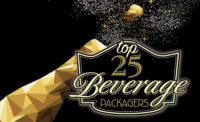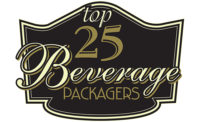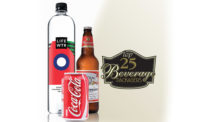Market Trends: Beverage Packaging
Beverage packaging: Popping the proverbial bubble
Is it time to rethink the packaging and marketing of beverage products?














With high-impact graphic designs, packaging structures tipping the scale of cool, and innovative closures that do much more than open and close the pack, you might call it the Twilight Zone of packaging. So are we choosing what is new and unique just to stand out – and if so, does it work?
With the recent soda tax and other consumer considerations, the beverage industry has begun to rethink how to package and market products in order to sustain sales. Chris Konyk, senior business consultant with Salient Management Company, says that beverage companies are resizing their products in response to health and obesity pressures. The beverage tax has heightened that pressure on the manufacturers to lighten the per-ounce tax penalty by slimming down the mega servings to something more palatable for the consumer’s wallet. Manufacturers realize that the tax on a 2-liter bottle or on multi-packs will add a volume-crippling barrier, so smaller portions will be the preferred approach until the consumer’s mindset changes.
In fact, our most recent reader poll only solidifies that smaller sizing in beverage is the wave of the future. Results from our recent reader poll, “Which beverage packaging trend will experience the most growth over the next few years?,” reveal that smaller sizing and using alternative materials like cartons, bag-in-box and pouches for wine will be the top two trends.
The greatest innovations in pouches are coming from the beverage segment, according to the 2017 Global Packaging Trends Report by Euromonitor (euromonitor.com) and sponsored by PMMI (The Association for Processing and Packaging Technologies) and other leading packaging associations. Here are a couple of new pouches now available.
HFactor water caters to the health, wellness and lifestyle needs of today’s active consumers. It is infused with molecular hydrogen, an antioxidant said to improve athletic performance, reduce inflammation and boost energy. HFactor’s completely redesigned 11-ounce hydro-pak features an easy open twist-off spout and hour-glass structure.
Ergonomic and eco-friendly, HFactor’s hydro-pack has a smaller environmental footprint, is flexible on-the-go, and preserves hydrogen in the water. The distinctive pouch has retained its signature aquatic look, now reflecting a sleeker and more minimalist design. Additional upgrades include a matte finish, horizontal logo, a new blue-green color palette and more prominently featured product benefits.
Another pouch innovation on shelves is Mifuwi, which stands for “My Fun Wine.” The DoyPak format delivers quality wine in a resealable, screw top pouch. Mifuwi launched in Spain in late 2016 as a breakthrough innovation and is already in the U.K., the U.S. and Mexico. The company focuses on the retail space as well as outdoor events – such as sports arenas, music venues and student campus events.
The Mifuwi pouch features bright colors and imagery, evoking fun and “bringing the party in your pocket.” It comes in My Fun Sangria and My Fun Wine-Cola in single serve, 187.5ml pouches.
A second water package making a spash is Flow water, a naturally alkaline spring water brand from Canada that recently launched in the U.S. Flow water is packaged in Tetra Pak’s (tetrapak.com) Tetra Prisma® Aseptic 500 Edge® carton pack with bio-based DreamCap™ in 500ml and 1-liter sizes. The bio-based DreamCap is made from high-density polyethylene (HDPE) derived from sugarcane. The packaging is 100% recyclable with 70% renewable resources. The octagonal design of the carton makes it stand out from competitors on shelf.
Flow was founded in 2015 and became an instant success with consumers. Since its inception, Flow has focused on providing 100% naturally alkaline spring water, mindfully sourced in Southwestern Ontario from the founder’s family owned aquifer. Due to the unique geological conditions at the source, the water is naturally packed with electrolytes, essential minerals and an alkaline pH of 8.1.
Offering a full line of coconut water and açai juice, Zola has been redesigned and rebranded to launch this summer. Zola’s new branding and packaging honors its commitment to plant-powered hydration with an illustration of an energy trifecta featuring people, plant-power and hydration. Bright colors and sharp, refreshing imagery round out the new packaging.
Naturally hydrating and slightly sweet, Zola coconut water comes in a variety of flavors including natural, with pulp, chocolate and the new pineapple flavor. The acai juice is bottled using only organically grown açai berries that are sustainably harvested and processed quickly to lock in nature’s flavor and goodness.
Packaged in 1-liter Tetra Packs, 17.5-ounce cans, and both 32- and 12-ounce PET bottles, Zola covers on-the-go single-serve and larger serving sizes.
No beverage article is complete without the infamous aluminum can. House Wine goes red, white and pink this summer with the launch of three 375ml cans. Two cans feature the brand’s best-selling varietals – Original Red Blend and Chardonnay – and the third is a new House Wine Rosé.
Launched in 2004 as one of Charles Smith’s first commercial offerings, House Wine Original Red Blend was among the first red blends to target everyday wine lovers with an iconic package at exceptional quality and value. In 2013, House Wine first launched its 3-liter box, to meet consumer demand and sourcing beyond borders to ensure its consistency from vintage to vintage.
The wine company chose cans for guaranteed fresh product and to cater to the grab-and-go lifestyle of busy, active wine consumers. In addition to the 375ml can, the new House Wine Rosé will also be available in a 750ml bottle and in the 3-liter box offering.
The beverage industry is constantly changing and evolving. Consumer demographics and purchasing behaviors make it a must for beverage packaging leaders to understand and capitalize on key consumer insights that identify growing trends. Recognize that beverages need to play a key role in consumers’ lifestyles – as a meal replacement, on road trips and at events, all the while being ever functional.
|
Challenges met with gusto for bag-in-box vodka, wine Standing out on a shelf full of boxed alcohol was important for Badge Mountain Winery’s Powers Wine Box and for Griffon Brands’ Premium Vodka in a Box. Both companies turned to Great Northern’s (greatnortherncorp.com) StrataGraph® web printing and converting process. The result? Solutions that solved the unique problems that bag-in-box packaging presents. Griffon BrandsGriffon Brands approached Great Northern about creating a high-end look and packaging for its Premium Vodka in a Box. The company wanted a box with high structural integrity that would work well in the refrigerator or freezer, something that would support bag-in-a-box construction and withstand the rigors of the supply. They also requested high graphic impact that would differentiate itself on the shelf. Chad Sedo, design manager for Great Northern’s StrataGraph explains, “The customer wanted more ‘pop’ on the shelf. They wanted the consumer to be drawn to this carton first, with a dazzling but still classy appeal.” The design team came up with ideas that were both attention getting and economically feasible. “We narrowed it down to an all-virgin paper substrate with a metallized PET outer; not only to give the shelf appeal that was needed, but also the structural characteristic needed to achieve refrigerator and freezer needs,” says Sedo. A multi-level embossing tool provided a highly detailed raised image of the company logos with metallic inks and spot high-gloss UV. It was critical that the graphic representation and high end look of the package stand out on the shelf and create visual impact for Griffon Brands’ new brand introduction. The design also incorporates a spout, making dispensing one shot or 34 a snap. Powers WinePowers Wine wanted its product to stand out on the shelf while also presenting a high end, premium look. They also had a specific concern about bulging of the carton which would affect the overall perceived value of the product. “We used metallic inks, spot high-gloss UV and multi-level detailed embossing to create that high-end look,” says Jeff Berger, design manager for Great Northern’s Stratagraph. Additionally, a handle was designed into the top of the Powers Wine Box so consumers could carry the carton easily and conveniently. Another challenge was the customer’s desire to create efficiency and sustainability in the packaging. By eliminating the traditional heavy glass bottle, Great Northern created efficiency in transportation, storage and manufacturing costs. The recyclable box contains the same amount of premium wine as four standard 750ml bottles. The new alternative packaging components are about half the weight of a traditional glass bottle. Both packaging solutions resulted in 79% less greenhouse gas emissions and used 91% less package materials than regular glass bottles, and all at a lower cost point. |
Looking for a reprint of this article?
From high-res PDFs to custom plaques, order your copy today!














